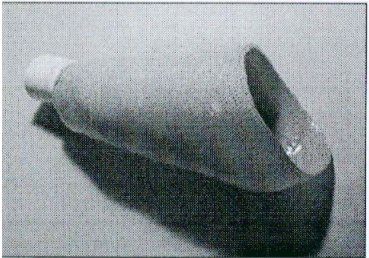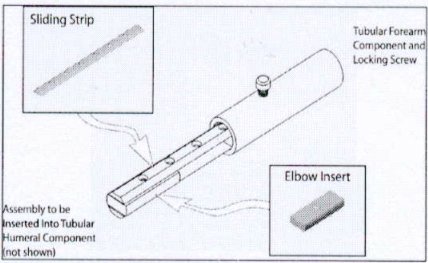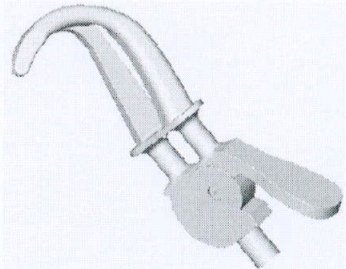DESIGN OF A LOW-COST PROSTHESIS FOR USE IN DEVELOPING REGIONS
ABSTRACT
The upper limb amputee population in developing regions is steadily increasing. Most of these amputees lack the funds to buy a prosthesis, and are therefore often denied employment. The goal of this project was to design an inexpensive, yet effective, upper extremity prosthesis that could be used in a manual labor or agrarian job. This has been accomplished by developing a new socket fabrication method, a simple locking elbow component, and a terminal device manufactured from Delrin.
BACKGROUND
Because of war, inaccessibility to healthcare, and an unsafe farming environment, the upper limb amputee population in developing countries is growing at an alarming rate. In India alone, it is estimated that the number of amputees needing prostheses increases by 17,000 annually (1). Owning a prosthesis often saves an amputee from a life of begging and facilitates his return to gainful employment. However, a severe lack of funds will prevent most amputees from ever receiving a prosthesis (2). This can be changed through the development of an effective and inexpensive upper limb prosthesis.
STATEMENT OF THE PROBLEM
The aim of this project was to develop a low-cost upper extremity prosthesis. It was designed using the following criteria. The total cost should not exceed $100. It should be easily manufactured and compiled as a kit for easy delivery to developing countries and/or rural America. The socket fabrication process should allow for fitting in the field by those with limited resources and experience. The arm should be durable for use in manual labor, especially in an agrarian environment. It should not be compromised by exposure to dirt and water. The arm should also be easily repaired by someone in the field with limited skills. Finally, the prosthesis should be culturally and aesthetically acceptable by a wide range of amputees.
RATIONALE
For many of the developing world's amputees, a prosthesis is a purchase they will never be able to afford. Although various organizations are involved with distributing used prostheses and manufacturing them at reduced costs, even these are often too expensive to be purchased by the people who need them (3). In addition to cost, there are other barriers that prevent amputees in the developing world from receiving prostheses. There is often a long waiting list for available prostheses, especially in those countries, such as Vietnam, where prosthetic work is filtered through the government. In his 1999 field survey of prosthetic use, Matsen reported a hierarchy favoring North Vietnamese war heroes first, followed by esteemed public officials, other North Vietnamese veterans, women involved in the war, civilian casualties, and "social amputees", those whose amputations were not caused by the war (2). In other cases, prosthetic centers are too remote, and amputees are unable to reach them (3). A prosthesis can enable an amputee to obtain a job, which he most likely will not be able to find without one. There is a need for an inexpensive upper extremity prosthesis that can be both fitted in the field and easily repaired without special equipment.
In fall 2000, an interdisciplinary team composed of both bioengineering and industrial design graduate students was created. The team sent out surveys to prosthetists working in developing countries to gain feedback on the needs of amputees in those regions. The team also compiled information on the state of prosthetics in developing countries and developed several designs for creating upper extremity prostheses out of locally available materials. In fall 2001, the cold molded socket fabrication method was designed and tested. Feedback on the socket was received from a trans-radial amputee, a local prosthetist, and from several attendees of the 2001 American Orthotic and Prosthetic Association conference. In 2002, the terminal device and elbow component were designed using SolidWorks 2001.
DESIGN
 |
 |
EVALUATION
Testing of the prototype will be performed in spring 2003. Both bench-top testing and amputee trials will be conducted. Bench-top tests will be performed to 1) test the terminal device to failure, 2) fatigue the plastic strips of the elbow component to failure, and 3) test the socket-pipe interface to failure. For the amputee trials, 6 amputees will be recruited through local prosthetic clinics. They will be both male and female adults of varied ethnicity. Hopefully, three will have
 |
DISCUSSION
An inexpensive upper extremity prosthesis has been designed. It will be tested and refined in spring 2003. The modifications will be used to create beta prototypes. Projected research includes testing these second generation prototypes with the target population in countries around the world.
-
Meanley, S. (1995). Different approaches and cultural considerations in third world prosthetics. Prosthetics and Orthotics International, 19, 176-180.
-
Matsen, S. L. (1999). A closer look at amputees in Vietnam: A field survey of Vietnamese using prostheses. Prosthetics and Orthotics International, 23, 93-101.
-
International Committee of the Red Cross. (1997). Assistance for victims of anti-personnel mines: Needs, constraints, and strategy [Brochure]. Coupland, RM: Author.
ACKNOWLEDGMENTS
Thank you to Dr. Gary Yamaguchi, Dr. James Sweeney, and Don Herring for their advice as members of my supervisory committee; to Brian McMahon and James Egan for gathering the survey information; and to Sander Nassan and Bill Atteberry for valuable feedback on the design.
Alison
Sitek
Harrington Department of Bioengineering
Arizona State University
Tempe, AZ 85287-9709
480-727-7041
480-727-7624 (fax)
alison.sitek@asu.edu
